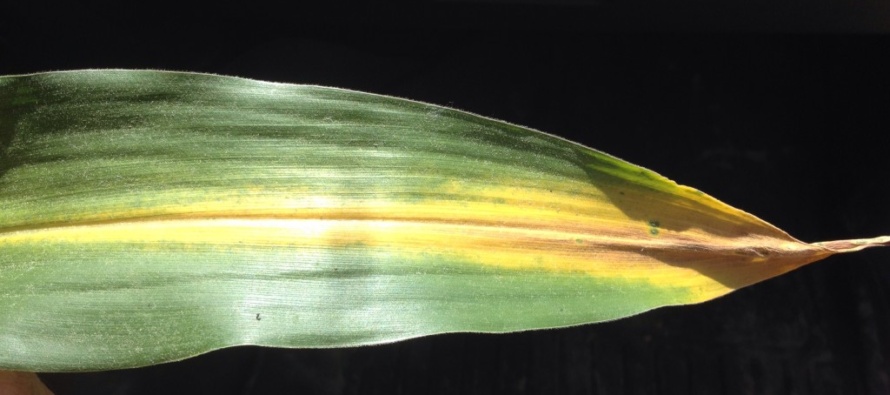What is Appropriate Timing for the “Tassel Shot” on Corn?

Related Articles
- 2010 Soybean And Corn Variety Trial Data 3
- Fertilizing Cotton with Poultry Litter 5
- Spring Nitrogen Fertility Suggestions for Wheat 0
Latest Tweets
 Interest in mid-season application of various inputs is certainly increasing as we try to improve efficiency and corn productivity through better management, different strategies and alternative products. Improved efficiency resulting from better timing may also reduce expenses and increase profitability. This naturally creates questions regarding the appropriate application timing to optimize crop response to various inputs, including nitrogen, foliar fertilizers, fungicides, or other products. Corn’s physiology may be a primary factor determining how responsive the crop may be to most of these factors.
Interest in mid-season application of various inputs is certainly increasing as we try to improve efficiency and corn productivity through better management, different strategies and alternative products. Improved efficiency resulting from better timing may also reduce expenses and increase profitability. This naturally creates questions regarding the appropriate application timing to optimize crop response to various inputs, including nitrogen, foliar fertilizers, fungicides, or other products. Corn’s physiology may be a primary factor determining how responsive the crop may be to most of these factors.
Corn physiological sensitivity to stress, photosynthetic capability and plant response to other limitations definitely varies with growth stage. Early reproductive growth stages, such as tassel (VT) or silk (R1) are the most sensitive to limitations, and plant tolerance generally increases as plants mature. Reproductive stages are also generally more sensitive than vegetative stages. Does this mean tassel stage is the best timing for various inputs? Not necessarily, if crop health is good and there are no limitations threatening, you shouldn’t expect the crop to be any more responsive to management timing at that specific time or growth stage. For example, ours and other Universities’ research overwhelmingly show automatic fungicide application at tassel stage is rarely going to improve corn yield or other plant attributes in the absence of foliar disease. This doesn’t mean that fungicide application has no value for corn production. Our recommendation is to use routine field scouting to monitor the corn crop for threatening disease, and better justify fungicide use when there is a reasonable opportunity of generating a profitable response.
 The topic generating the most discussion this season is supplemental nitrogen application near tassel. A lot of the crop is approaching tassel stage and dry conditions have been hampering fertilizer application. So should you be concerned about missing the opportunity for best response, or do you have some leeway for N application of your “tassel shot?” The answer depends on the condition of your crop and what has transpired until this point. These two scenarios generally address most situations we are likely to encounter:
The topic generating the most discussion this season is supplemental nitrogen application near tassel. A lot of the crop is approaching tassel stage and dry conditions have been hampering fertilizer application. So should you be concerned about missing the opportunity for best response, or do you have some leeway for N application of your “tassel shot?” The answer depends on the condition of your crop and what has transpired until this point. These two scenarios generally address most situations we are likely to encounter:
- If your crop is nitrogen deficient prior to tassel, then it is very important to try to correct that deficiency prior to tassel in order to optimize yield potential. Such catastrophic nitrogen deficiency is usually due to weather preventing intended nitrogen application, or extensive N losses resulting from extended soil saturation. Nitrogen deficiency can be recognized by yellowing of lower leaves beginning at the leaf tip and progressing down the midrib in a “V” shaped pattern as shown below. Since the fertilizer will not be available to the crop until it is incorporated, it is best to apply N prior to forecast rainfall or over-head irrigation and well prior to the critical pollination time. However, realize that supplemental nitrogen will not overcome stunting caused by soil saturation or soil compaction.

- If your crop is currently healthy and dark green, and your “tassel shot” is part of a planned program to improve seasonal nitrogen efficiency, then application timing should not be particularly critical. This scenario is generally going to be far more likely for Mississippi growers, especially if you implement a sound, split-application strategy which we advocate. Your primary goal in this strategy is to maintain ample nitrogen to fully support productivity until the end of the long growing season, when nitrogen supply is most likely to diminish. In other words, in this scenario, it is not necessary to sweat whether you apply supplemental nitrogen at V12, V15, tassel or even brown silk. In this case, you should strive to time application when soil is reasonably dry and subsequent rainfall is forecast to quickly incorporate fertilizer with minimal loss.
Rather than focusing efforts exclusively at the “magic growth stage,” it is normally much more important to let the crop and prevalent weather conditions dictate what is needed and when. Realize corn is less vulnerable to stress as the crop approaches maturity, but yield reduction may occur all the way to physiological maturity. If you need help assessing the degree of response likely from specific issues and timing, feel free to contact any of our crops team for further assistance.




Let me tell You a sad story ! There are no comments yet, but You can be first one to comment this article.
Write a comment